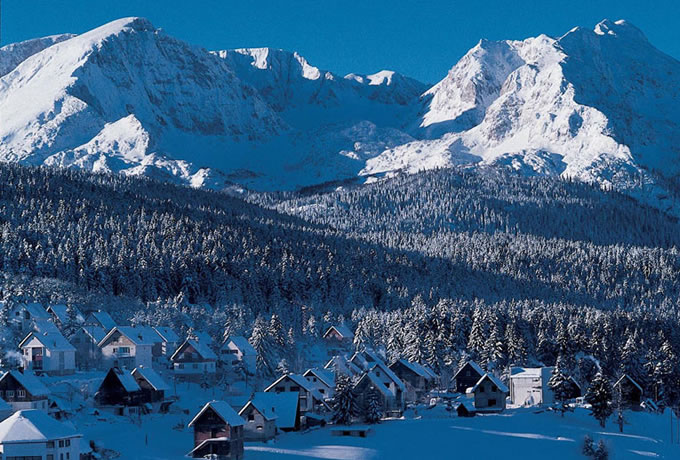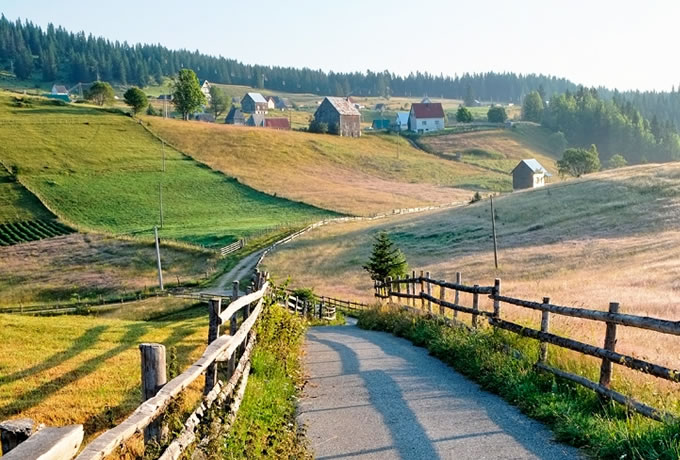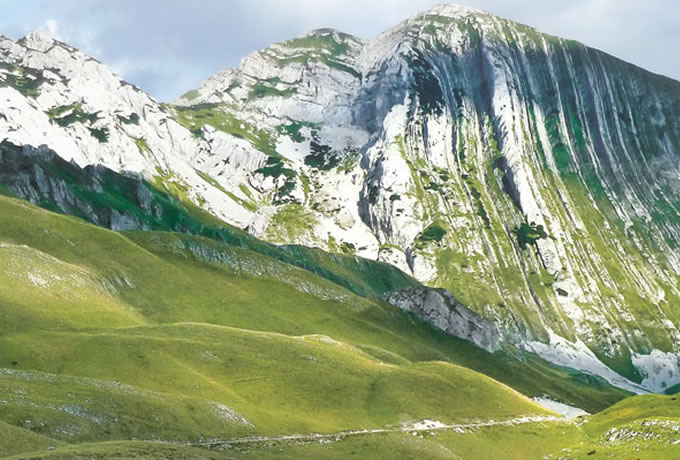
Zabljak
The town of Žabljak is located in the northwest of Montenegro, in the heart of the Durmitor region, at an altitude of 1450 meters above sea level and represents the most urban urban settlement in the Balkans. It is located at the foot of Durmitor and is surrounded by 23 mountain tops of over 2200 meters, with 18 mountain lakes and canyon of the Tara River, the deepest in Europe. Today, more than 4500 inhabitants live in Žabljak and its surroundings. The first Slovenian name of this place was "Varezina voda", credited with the strong source of potable water, around which the settlement was built. Later, it gets the name "Hanovi" or originally "Anovi", where the commercial caravans were resting. Today's name Žabljak gets officially in 1870, when the church, the school and the captain's home began building on the same day. In the war days and the devastation of old buildings they disappeared. Only the Church of St. John was left. The transformations, erected in honor of the Turks in 1862. The birth of Žabljak was followed by the beginnings of several trade and crafts and cafes. Thus, in the eighties of the 19 century, Žabljak was also a kind of market, which had the effect of gradually taking over the role of the administrative center of the Durmitor region.In the period before the Second World War, Žabljak represented a vulture with a typical mountain architecture. Already in this period, unique nature begins to attract a large number of tourists from the then Kingdom of Yugoslavia but also from abroad. Especially because of their connections with Montenegro there were numerous Italian guests. In addition to its magnificent natural environment, the richness of this area in the animal world and the benefits of hunting and fishing leads to Zabljak and many enthusiasts in this type of sport. During the Second World War, the vulture was burned. All homes, institutions and all of this little mountain village were burned away except for fires and carnations. From then on to the present day, Žabljak built and built and became the center of winter tourism in Montenegro. Unique and diverse natural resources, in such a small space, recommended Žabljak for the ecological capital of the first ecological state in the world. The Montenegrin Parliament's delegates, fresh mountain air, at an extraordinary session, heavily under the skies, made the decision to proclaim Montenegro for the first ecological state and unanimously elected Žabljak to its capital. In the vicinity of Žabljak there are a large number of villages and their age is very different. Some of the Durmitor villages exist for centuries, while some have been formed later. Settlers who have formed these settlements have always chosen more suitable and sheltered habitats, giving preference to dotted sides and green meadows. A number of these villages were formed in places where original homes or old settlements were originally built. As for the style of construction itself, there are significant differences in this respect. The largest number of villages is so called. "Broken"type and house can be far apart from each other. There are also villages where houses are closer to one another, but in general, the villages and houses are built without any particular order and order. In the villages of Durmitor, it is quite common for villages to divide up and down, so they call it so. The lower village is, as a rule, an older village, while the upper one is formed by time, perhaps from the cemetery or seasonal settlements of the lower villagers.
Climate
The largest part of the Durmitor region has an average annual temperature of 2 to 8 degrees Celsius. It is 120 days per year under snow, more than 15 centimeters, and ski terrains, which are at a higher altitude, have a snow cover suitable for skiing 150 days a year. In the higher parts of Durmitor, and throughout the summer, snow can be seen and in the Kalice area the so-called " "DEBELI NAMET", long 200 to 300 meters, where you can ski in the middle of summer.
The climate has its characteristics, from the parish in the canyons of the river, over subplanins up to 1200 meters up to the typical Alpine. Winters are long and cold, the summers are relatively short and fresh, and it is interesting that autumn is warmer than spring. Population from these areas belongs, according to Jovan Cvijic, to the Dinaric type of man. He states: "These are people of strength and power, extremely tall, slim, elastic, never obnoxious, face full of expressions, strong cheeks, hawks' eyes, the most beautiful straw of the Balkan Peninsula." Heavy times, as well as difficult conditions of life, were the people who lived here, in the eternal struggle, fighting with nature, trying to win as much as possible and do their ally. This eternal struggle led to the fact that they were only the strongest, so the migration of the population was great. Those who remain and remain confirm the poet's thought that only stones that are harder than stones are born from the stone, as well as the stone cushion and the mountain chair.
Such are the people who are taller, rocky and harder than the mountain, which has kept them and always ready to defend their stone, as the most valuable thing. The natural ambience, the conditions of business and the way of life, have particularly researched in traditional architecture, craftsmanship for work and household items, as well as in the fashion of the people in this area. Residential and household items are traditionally made of wood, and items for clothing and clothing made of wool, hemp, linen and leather. Particularly beautifully crafted and often carved household items made of wood are specially crafted. One such item is a "pewter", made of hardwood, usually of a javora, and is distinguished by a beautiful form, a fancy ornament and a prefinished carving. The cradle is also an object whose design, decoration and design is given special attention, as it is a cult object that is almost never alienated. Families are especially fond of having beautiful carved squirrels, often featuring exceptional artistic creations of local masters. Clothing items are made of hand-woven materials or knitted with wool. Of woven fabrics, they have a particularly beautiful look with rolled ponies, velvets and other coverings, followed by jewelery, dents, skirts, skirts, parts of traditional Montenegrin costumes and other garments made of wool. From knitwear, the beauty and the charm of motifs are highlighted by sweaters, scarves, knitwear and socks. As footwear, the opaque made of sheep skin was used. Ethnoarphic treasures show great wealth and the value of people at this end, but it gradually disappears under the influence of new industrial products as well as modern lifestyles. Some of these old crafts, however, have endured a new era. Even today, on Žabljak you can buy, as a, but also as a matter of certain usable value, a large number of items listed. Today Žabljak economically seeks on TOURISM and the production of healthy food, which will surely help him to take on the place he deserves. The new way of thinking, the private initiative, the entry of foreign capital and openness to the world, will make Žabljak become a highly developed tourist center, a European format. Here the season runs throughout the year: winter tourism, spring and autumn (seminars, rafting, hunting tourism ...) and summer (vacation and recreation, sport tourism).
By visiting this place, you will surely feel the true peace, the blend of tradition and the modern, unbelievably natural environment, interesting hospitality, quite unusual (but beautiful and interesting) and certainly free your thoughts from everyday stresses.




